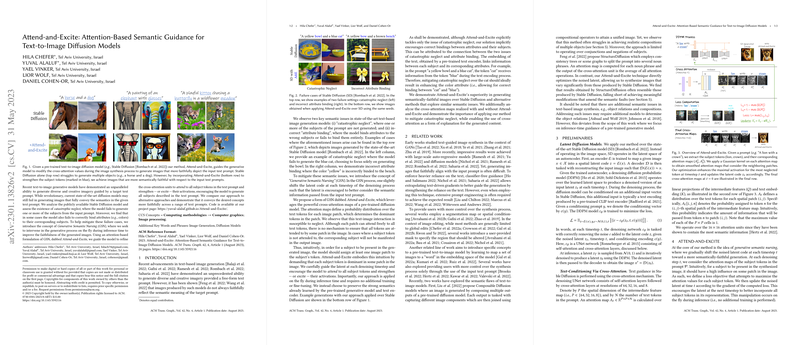Attend-and-Excite: Guiding Text-to-Image Diffusion Models with Attention-Based Semantic Techniques
The paper "Attend-and-Excite: Attention-Based Semantic Guidance for Text-to-Image Diffusion Models" addresses a critical issue in the field of text-to-image generation—ensuring semantic fidelity between input text prompts and their generated visual counterparts. The core contribution is an innovative framework, Attend-and-Excite, which leverages cross-attention mechanisms to refine the generative process of pre-trained diffusion models, specifically targeting the mitigation of catastrophic neglect and incorrect attribute binding in the generative output.
Problem Context
Recent advancements in diffusion models, exemplified by Stable Diffusion, have pushed the boundaries of text-to-image synthesis. Despite their capabilities in generating diverse imagery, these models often fail to accurately capture all elements described in a text prompt. Two primary challenges identified are "catastrophic neglect," wherein some subjects in the prompt are entirely omitted, and "incorrect attribute binding," where attributes are mismatched or improperly associated with the wrong subjects. This lack of semantic precision undermines the end goal of text-to-image models: to generate images that are an accurate depiction of the text prompt.
Approach
The Attend-and-Excite technique innovatively addresses these semantic issues by employing a process termed Generative Semantic Nursing (GSN). Unlike other interventions requiring extensive re-training or fine-tuning, Attend-and-Excite intervenes during inference, preserving the strong semantic foundations of the underlying model. The model operates by adjusting the attention maps, specifically within the cross-attention layers of the UNet architecture in diffusion models, to reassess and amplify, or "excite," attention to the desired subject tokens.
This is accomplished by algorithmically updating the latent representations during the denoising steps. Through a calculated approach, attention maps are smoothed via Gaussian kernels to prevent adversarial patch activations and iteratively refined to ensure that each subject token in the prompt reaches a specified threshold of attention. By doing so, a robust mechanism is created that not only emphasizes neglected tokens but also reinforces the correct coupling of attributes naturally.
Evaluation and Results
Significant empirical evidence supports the efficacy of Attend-and-Excite in outperforming existing benchmarks, including Composable Diffusion and StructureDiffusion. Evaluation on a carefully curated dataset—comprising various subject-object combinations with varied complexities—shows substantial improvements. Attend-and-Excite achieves higher CLIP-based image-text similarities, indicating a more accurate semantic translation from text to image. Text-text similarities leveraged through BLIP-based captioning further validate its ability to maintain prompt integrity, demonstrating a reduction in neglect and an improvement in attribute bindings without introducing undesirable artefacts in the image generation.
Implications and Future Prospects
The introduction of Attend-and-Excite marks a significant stride in enhancing semantic fidelity in text-to-image generation. By addressing core issues in semantic accuracy, this method propels the functional capabilities of text-to-image models closer to human expectations. The paper opens avenues for integration within existing generative frameworks, offering potential applicability in areas that demand high precision in visual content generation, such as digital design and visual storytelling.
Further exploration could investigate the applicability of GSN principles across diverse generative tasks beyond diffusion models, potentially extending to video synthesis, multimodal understanding, and more sophisticated text and visual LLMs. As these developments progress, attention-based guidance methods like Attend-and-Excite may well catalyze a paradigm shift towards more interpretably semantic and user-aligned AI-generated content.
In conclusion, this paper presents a methodological advancement that effectively navigates the intricacies of semantic alignment in generative models, establishing a foundation upon which future AI systems may further bridge the gap between human language and machine-generated imagery.
